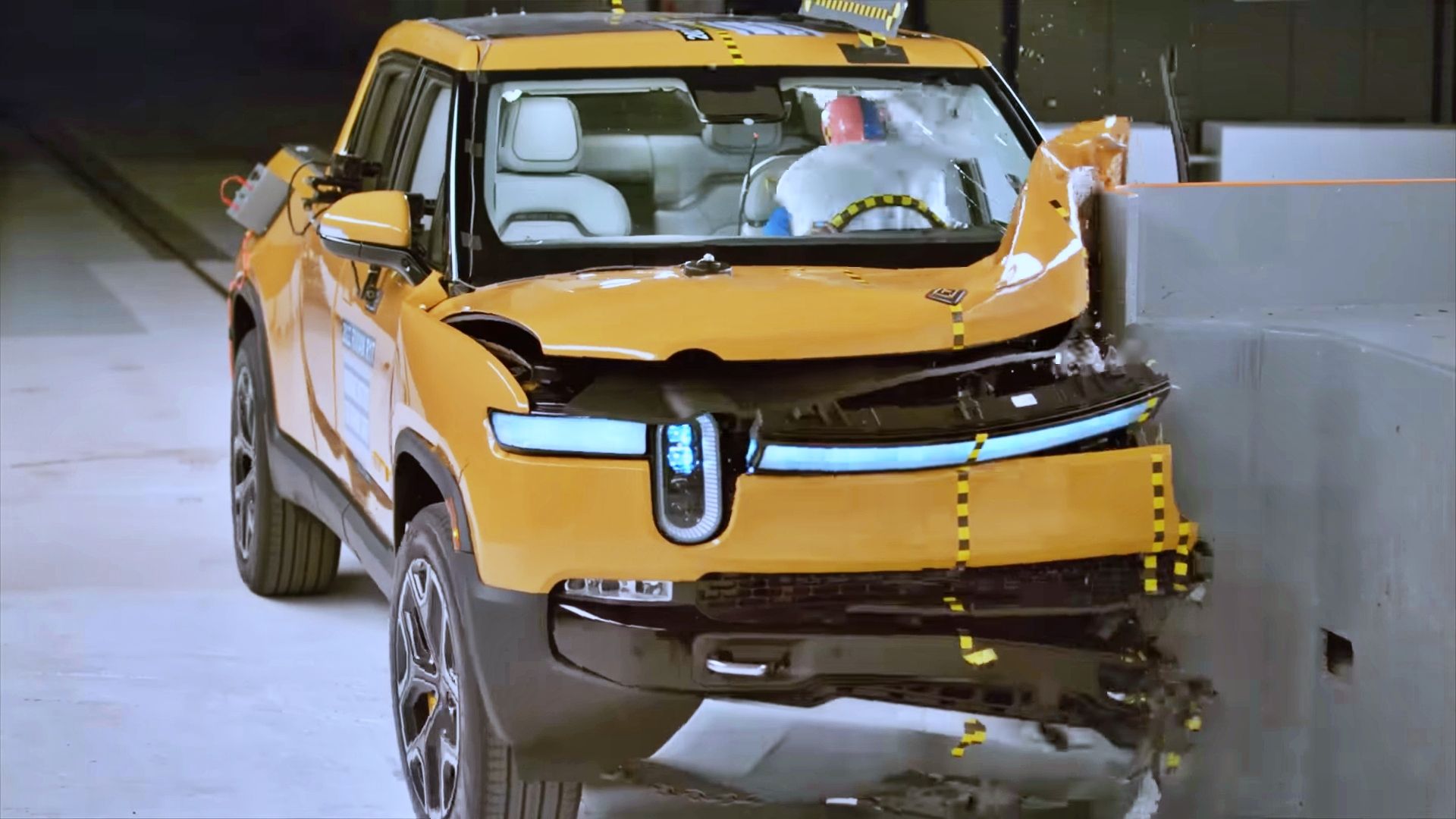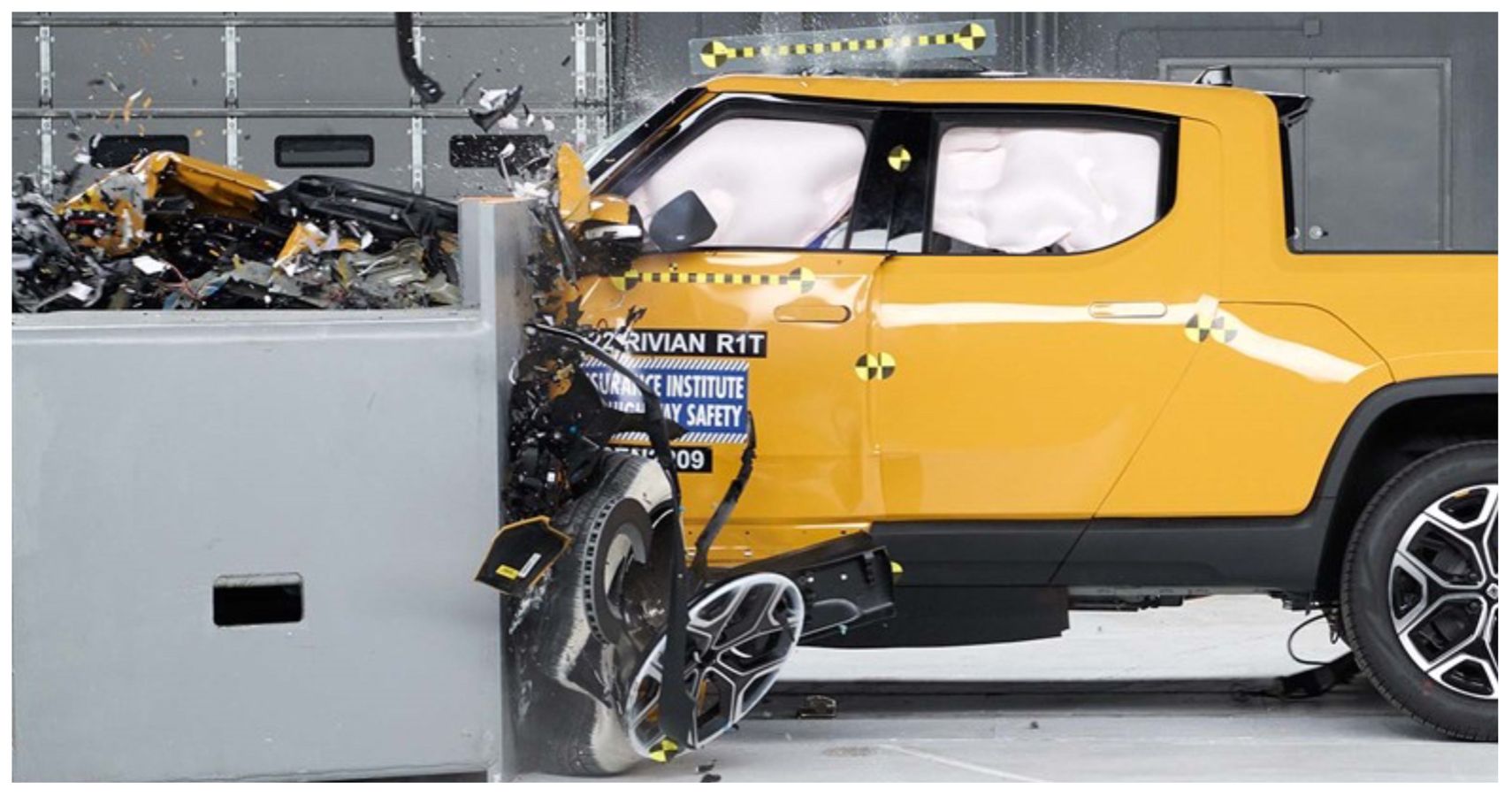The Insurance Institute for Highway Safety (IIHS) is a non-profit organization that crash tests and grades vehicles to determine their level of safety. Their overall goal is to encourage safer vehicles and reduce traffic fatalities. A good rating from the IIHS can translate into sales as safety is something consumers consider.
Recently, Rivian submitted its R1T all-electric pick-up truck to IIHS for testing, but there was one potential problem. Electric trucks, the Rivian R1T included, are much heavier than their gas-powered counterparts. The IIHS wasn't sure their equipment could handle the extra load from the all-electric pickup.
Electric Trucks Are Heavy Metal Machines
Full-size electric trucks need big battery packs for power and range, but that comes with added weight. The GMC Hummer EV's battery pack weighs nearly 3,000 pounds, pushing the overall weight of the vehicle to 9,000 pounds. At that weight, it's actually classified as a heavy-duty truck.
To give you some context, a gas-powered 2022 Dodge Ram weighs 5,400, a 2022 Ford F-150 weighs 5,700 pounds, and a 2022 Chevy Silverado weighs 5,600 pounds. Extras can add some weight to these trucks, but generally speaking, they aren't freakishly heavy like their EV cousins.
The Rivian R1T has four electric motors, two in the front and two in the back, which puts out to 835 horsepower that can rocket the truck from 0-60 in 3 seconds. The 180 kWh battery provides that power as well as over 400 miles in range, but also adds considerable weight to the vehicle. Even without the auxiliary batteries that can be mounted in the bed, the truck tips the scales at 7,148 pounds.
RELATED:
Is The Rivian R1T Too Heavy To Crash Test?
After getting a Rivian R1T for testing, the IIHS was presented with a serious question. Could it actually be tested? The heaviest vehicle they had ever tested before was the Audi e-tron electric SUV at 6,103 pounds. They weren't sure if their equipment could handle a heavier vehicle.
The way testing works is a vehicle is hooked up to a pulley on a track and towed at 40 mph into a front-end offset collision. The vehicle is in neutral and doesn't operate under its own power. The IIHS didn't know if their pulleys and motors were strong enough to tow the behemoth Rivian R1T or if they could get it up to speed.
To test the equipment, the IIHS loaded up a Ford F-150 with metal plates and other ballast, bringing its weight up to 9,500 pounds. The test went off without a hitch, but all the weight they added to the bed went crashing through the cab. Luckily, this wasn't a test of a loaded Ford, it was just to demonstrate if their equipment could actually handle a heavy vehicle.
Ready To Destroy A Rivian R1T
With the equipment okayed, the IIHS was now ready to crash a 2022 Rivian R1T EV Adventure Trim Crew cab 4wd. While many may not want to see such an awesome machine destroyed, it should be remembered this is for science, and more importantly, safety.
While it's almost certain the 40 mph crash totaled the Rivian R1T, these tests are geared to determine the survivability of a head-on in the vehicle. The crash test dummy got rocked a little bit but looked like he could walk away, if dummies could walk, from this collision.
In fact, the Rivian R1T passed with flying colors. The IIHS gave it a "good" rating, which is their highest grade, in all relevant categories. The safety cage held and the driver sustained no serious injuries. The Institute also gave the Rivian a "superior" rating on the included collision avoidance safety systems.
It's important to note that the Rivian R1T was crashed into a solid immovable barrier. In a real-world crash situation, there would be more give in the impact, and it wouldn't be nearly this severe. With the weight of the R1T, the driver might not even notice hitting something like a Kia Rio.
But Did The Skateboard Survive?
The Rivian R1T, like many EVs, sits on a skateboard, which is a chassis that houses the battery, motors, and other electronic components. It's what makes these trucks so heavy, but also the single most important part of the vehicle. Any damage to the skateboard means the truck is inoperable.
In the IIHS test, though not noted in their report, it looked the Rivian R1T's skateboard took significant damage. Something like that has the potential to total the vehicle since most of the expense is in the skateboard. It would be an interesting and useful test for all EVs to see how stout their skateboards are in a variety of crash scenarios.
The Rivian R1T Doesn't Need To Go On A Diet
At over 7,000 pounds, the Rivian R1T wasn't too heavy to crash test, and it's likely the extra weight helped it score so high. It's a simple principle of physics that in a collision, the heavier denser object wins.
The IIHS crash test helps make the already attractive Rivian R1T even more alluring. It's fast like a supercar, has a slick look, and is now one of the safest vehicles on the road. All that's left to do, is for Rivian to bring one of these in the Ram/F-150/Silverado price range.




